Your new favourite go-to gardening books
“The Prairie Gardener’s Go-To Garden series offers knowledgeable yet accessible answers to questions covering a broad range of topics to help you cultivate garden success. Get growing!”
—Lorene Edwards Forkner, gardener, writer, author of Color In and Out of the Garden
“All your gardening questions answered! Reading the Guides for the Prairie Gardener series is like sitting down with your friendly local master gardener. Delivers practical guidance that will leave you feeling confident and inspired.”
—Andrea Bellamy, author of Small-Space Vegetable Gardens
“A beautiful and incredibly well-written series of books on earth-friendly gardening. . . A pleasure just to leaf through, but the accessible writing and level of expertise makes them essential to any gardener’s library. Although they’re geared to prairie gardeners, I found great information that transfers anywhere . . . Highly recommended!”
—Diane Miessler, certified permaculture designer and author of Grow Your Soil!
“Although each guide touches on regionally specific information, the wisdom of these seasoned gardeners applies to any garden, where ever it may be . . . These question-and-answer styled books get to the root of the matter with Janet and Sheryl’s unique wit and humour.”
—Acadia Tucker, author Growing Perennial Foods
Order a copy:
It looks like you’ve discovered the Guides for the Prairie Gardener.
This budding series puts the combined knowledge of two lifelong prairie gardeners, Janet Melrose and Sheryl Normandeau, at your grubby fingertips. Whether you’ve just cleared a few square feet for your first bed of veggies or are a seasoned green thumb stumped by that one cultivar you can’t seem to master, we think you’ll find these knowledgeable gardeners the ideal teachers.
Find answers on seeds, soil, trees, flowers, weather, climate, pests, pots, and quite a few more. These slim but mighty volumes, handsomely designed, make great companions at the height of summer in the garden trenches and during cold winter days planning the next season. With regional expertise, elegance, and a sense of humour, Janet and Sheryl take your questions and turn them into prairie gardening inspiration.
 Too often people think of vegetable gardening in the prairies as challenging, but certified master gardeners Sheryl and Janet are here to show you how rewarding it can really be.
Too often people think of vegetable gardening in the prairies as challenging, but certified master gardeners Sheryl and Janet are here to show you how rewarding it can really be.
From planning to planting, they encourage you to take a hands-on approach with your prairie garden. They let you know when—and how!—to transplant your carefully nurtured seedlings in the spring, ways to shelter your plants from that inevitable July hailstorm, and how to determine how much irrigation is necessary in the arid prairie climate. They help you figure out if you should prune your tomatoes, how to hold up your pumpkins off the ground, and maximizing your harvest by planting in succession. And they show you how you can directly influence the quality of your produce, minimizing problems such as woody radishes, buttoning cauliflower, and split cabbage heads.
This Q&A-style resource covers all your most common questions: cultivation practices; preventing damage from frost, flood, and drought; harvest and storage; and specifics on the veggies you love to grow.
Click here for more info
 Whether you’re an experienced prairie gardener or have just a few weeks under your belt, chances are you’ve come to know at least a couple of pesky insects, moulds, or much larger lurkers on a first-name basis. But what to do about these interlopers who can seem hell-bent on ruining your hard work? Lifelong gardeners Janet and Sheryl are here to help.
Whether you’re an experienced prairie gardener or have just a few weeks under your belt, chances are you’ve come to know at least a couple of pesky insects, moulds, or much larger lurkers on a first-name basis. But what to do about these interlopers who can seem hell-bent on ruining your hard work? Lifelong gardeners Janet and Sheryl are here to help.
Should I use landscape fabric? Does vinegar work? What do I do about tent caterpillars? Why are my potatoes scabby? Why does it look like my cabbages have been attacked by miniature buckshot? And the recurring What is this thing?! Janet and Sheryl take your most pressing questions in this Q&A-style resource on all the prairie gardener’s most common pests, including thistle, dandelion, crabgrass, slugs, aphids, beetles, moths, mildew, fungus, rust, deer, rabbits, porcupines, and even other people’s pets.
Using an integrated pest management approach, Janet and Sheryl show you how to identify the culprit and how to deter it, while respecting the broader environment.
Click here for more info
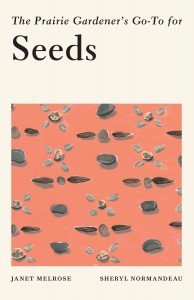 Certified master gardeners Sheryl and Janet offer you all the tools you need to start seeds, ensuring they thrive and grow into beautiful mature plants. They answer your questions on things like how to determine the viability of seeds, the difference between an heirloom, heritage, and hybrid seed, the best containers and planting media to use, when and how to use growing lights, troubleshooting common problems such as damping off and overwatering, the proper methods for hardening off transplants and planting them out.
Certified master gardeners Sheryl and Janet offer you all the tools you need to start seeds, ensuring they thrive and grow into beautiful mature plants. They answer your questions on things like how to determine the viability of seeds, the difference between an heirloom, heritage, and hybrid seed, the best containers and planting media to use, when and how to use growing lights, troubleshooting common problems such as damping off and overwatering, the proper methods for hardening off transplants and planting them out.
And they don’t stop at addressing starting seeds indoors—they also give you the information you need to direct sow straight into the garden, and on winter sowing. Then they delve deeply into how you can collect and save seed for the future so that you can continue the cycle for future growing seasons.
The book is complete with detailed charts to give you specific information about seed starting on the Prairies, with several plant lists to help you decide what selections work best in a variety of situations and conditions.
Click here for more info
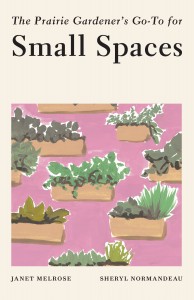
Not everyone in the prairies has a big, wide-open space in which to garden, but with a little extra know-how and some specialized techniques, you can maximize your success in the space you have.
Lifelong gardeners Sheryl and Janet are here with answers to all of your big questions about small-space gardening including which types of growing media to use in containers or raised beds, how to properly fertilize and water your container plants, including grow bags and containers made from various types of materials, how to get started in square foot gardening, how to reap the rewards of succession planting and catch-cropping, how to build raised beds, wicking beds, and sub-irrigation planters, which veggies and vines to grow vertically, how to keep hanging baskets looking lush and full of blooms all summer, and many more.
Whether you’re using container gardens, raised beds, small plots, and postage-stamp sized yards, or trying your hand at vertical gardening, certified master gardeners Sheryl and Janet answer all your questions about how to do so successfully on the prairies. Small-space gardeners are a different breed and what they create can be magic!
Click here for more info
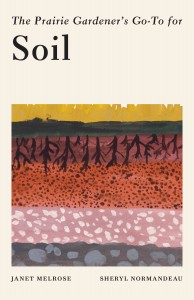 Soil is a whole world under our feet, full of fun words you may have heard but never quite understood, like hard-pan, humus, loam, and tilth. In this fifth book in the Guides for the Prairie Gardener series, master gardeners Janet and Sheryl provide the basics of soil science so that you can apply it to your gardening endeavours.
Soil is a whole world under our feet, full of fun words you may have heard but never quite understood, like hard-pan, humus, loam, and tilth. In this fifth book in the Guides for the Prairie Gardener series, master gardeners Janet and Sheryl provide the basics of soil science so that you can apply it to your gardening endeavours.
They’ll guide you through whether or not you should be using organic, inorganic, or natural fertilizer; how to test the chemical composition of your soil; what the numbers on the packages of fertilizer mean; how and when to amend your garden’s soil; whether to use hot compost, cold compost or warm compost; what exactly mycorrihizal fungi does; whether you should include egg shells, coffee grounds and banana peels in your compost; and much more.
In this handy Q-and-A guide, focused specifically on the prairie region, you’ll learn what particles are dominant in your soil, how to make successful compost, the value of mulch, tips on no-till practices and cover crops, and solutions to problems such as compaction, heavy clay, salinity, and soil-borne diseases. With Janet and Sheryl’s insight you’ll soon be well on your way to healthy, happy soil.
Click here for more info
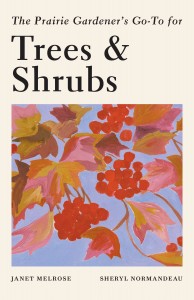 Trees and shrubs together make up the bulk of Earth’s biomass. They are responsible for carbon dioxide storage, oxygen production, movement of water, and a host of other functions. In our gardens, trees and shrubs provide numerous benefits, including reducing air, light, and noise pollution, protecting our homes from wind, cold, and heat, and providing habitat for birds, insects, and other animals.
Trees and shrubs together make up the bulk of Earth’s biomass. They are responsible for carbon dioxide storage, oxygen production, movement of water, and a host of other functions. In our gardens, trees and shrubs provide numerous benefits, including reducing air, light, and noise pollution, protecting our homes from wind, cold, and heat, and providing habitat for birds, insects, and other animals.
In the sixth book in the Guides for the Prairie Gardener series, lifelong gardeners Janet and Sheryl offer advice and recommendations to help you successfully grow trees and shrubs from the ground up by advising whether to choose small or large trees and shrubs to match your needs; the fine art of digging holes; care and feeding (and mulching and watering and fertilizing); when and how to train and prune for your plant’s health and appearance; how to protect young trees and shrubs through a bitter winter; when to call your local arborist; and all your tree-related questions.
Janet and Sheryl help you trouble shoot on common issues like a tree’s failure to produce fruit, girdling, and weather-related challenges, as well as an introduction to pests and diseases like leaf miners, leaf rollers, leafhoppers, and their friends. They also provide prairie-specific lists of recommended trees and shrubs for flower displays, autumn colour, beautiful bark, smaller yards, hedges, and shade.
Click here for more info
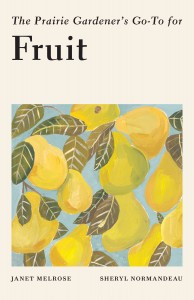 Strawberries, blueberries, saskatoons, pears, plums, apricots, cherries, currants, kiwi . . . There are lots of great reasons to grow your own. There’s the unparalleled taste of fresh produce to consider, and the opportunity to help reduce ever-rising grocery bills. Then there’s the ornamental appeal (think grape vines and apple blossoms).
Strawberries, blueberries, saskatoons, pears, plums, apricots, cherries, currants, kiwi . . . There are lots of great reasons to grow your own. There’s the unparalleled taste of fresh produce to consider, and the opportunity to help reduce ever-rising grocery bills. Then there’s the ornamental appeal (think grape vines and apple blossoms).
Whether you’re growing an orchard in a rural area, planting a couple of currant bushes or haskaps in a small urban yard, or a container of squash on a balcony, you’ll find help and inspiration here.
Janet and Sheryl answer your questions on things like placement for sun- and shade-loving plants; mulching, hilling, trellises, and those oh-so-fancy espaliers; troubleshooting pesky spots, scales, worms, flies, and other killjoys; and preventing weather damage and prepping your plants for winter.
With a primer on what exactly counts as fruit (scientifically and culturally) and Prairie-friendly lists of species and varietals for every space and inclination, you’ll soon know your drupes from your pomes, your berries from your pepos and be well on your way to harvesting the fruits of your own labour (yes, we went there).
Click here for more info
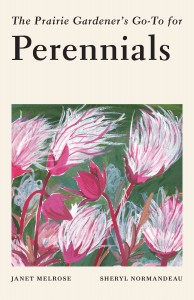 Perennials are those species whose stems and leaves die back to their crowns each fall, but whose roots remain alive throughout the non-growing months. They include showy flowers like peonies, poppies, lilies, clematis, and lupine, but also edibles like asparagus, fiddlehead ferns, sunchokes, and rhubarb.
Perennials are those species whose stems and leaves die back to their crowns each fall, but whose roots remain alive throughout the non-growing months. They include showy flowers like peonies, poppies, lilies, clematis, and lupine, but also edibles like asparagus, fiddlehead ferns, sunchokes, and rhubarb.
In this guide prairie gardening experts Janet Melrose and Sheryl Normandeau answer questions like what are the best perennials for building biodiversity in your garden? Which varieties grow best in containers? How do you keep enthusiastic re-seeders from taking over your garden?
The pair dedicate a chapter to perennial vegetables and another to mitigating common pests and diseases. The final chapter is a perennial hall of fame, an extended list of recommended plantings for colour, native species, rock gardens, ground cover, fragrance, spring champions, and all-season displays. Janet and Sheryl give you the information you need to make your perennial garden as successful as you can while promoting biodiversity and creating a healthy habitat for pollinators and wildlife.
Click here for more info
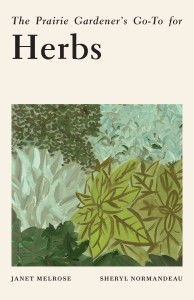
If you’ve ever stood in the produce section of the grocery store trying to pick out the least wilty of those little plastic containers of herbs, you’ll understand the appeal of growing your own. In the ninth installment of their prairie gardening series, seasoned (ahem) gardeners Janet Melrose and Sheryl Normandeau answer all your questions about growing these culinary, medicinal, and spiritually beneficial plants, including their potential for use in pest management and as hardy lawn replacements.
Beginning with the where (containers, raised beds, spirals, and more), the pair then provide guidance on choosing healthy plants, how to nurture herb seedlings, soil needs, watering, dealing with aggressive spreaders (hello, mint!), pest prevention, overwintering—including how not to kill that potted rosemary you brought inside for its own darn good—and lots of ideas for storing and enjoying your herbal goodies, from drying and freezing to making tasty infused oils, vinegars, and butters.
The final chapter is a roundup of herbs for all occasions and locations, including the pair’s top choices for insect repellers, butterfly and hummingbird attractors, edible flowers, and ingredients for herbal tisanes.
Click here for more info
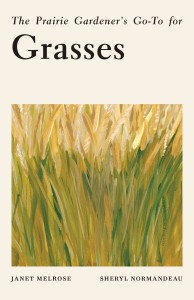
Was ever there a prairie-er subject than grass? Important providers of habitat and food for numerous wildlife species, grasses also serve an integral role in erosion control. For the gardener they can open up a bounty of landscaping options, from the lawn to the pond. In the tenth installment of their popular gardening guide series, lifelong gardeners Janet Melrose and Sheryl Normandeau give you the skinny on everything from sod to sedges and raking to rushes.
Following a primer on what exactly defines a grass, Sheryl and Janet take your questions on matters like clumpers vs spreaders, mulching and fertilizers, how to tackle problems like chinch bugs and fairy rings.
The pair dedicate a chapter to lawns, providing a wide selection of alternatives to the tried and true commercial lawn species and answer questions on raking, aerating, laying sod, mowing, and dealing with dogs and all the damage they seem hardwired to do.
Taking your questions on aquatic grasses, as well as edible species (like wheat, rye, and corn), and finishing up with a hall of fame of the best grasses for your every plan and purpose, the authors are sure to expand your knowledge on this truly homegrown topic!
Meet the Experts
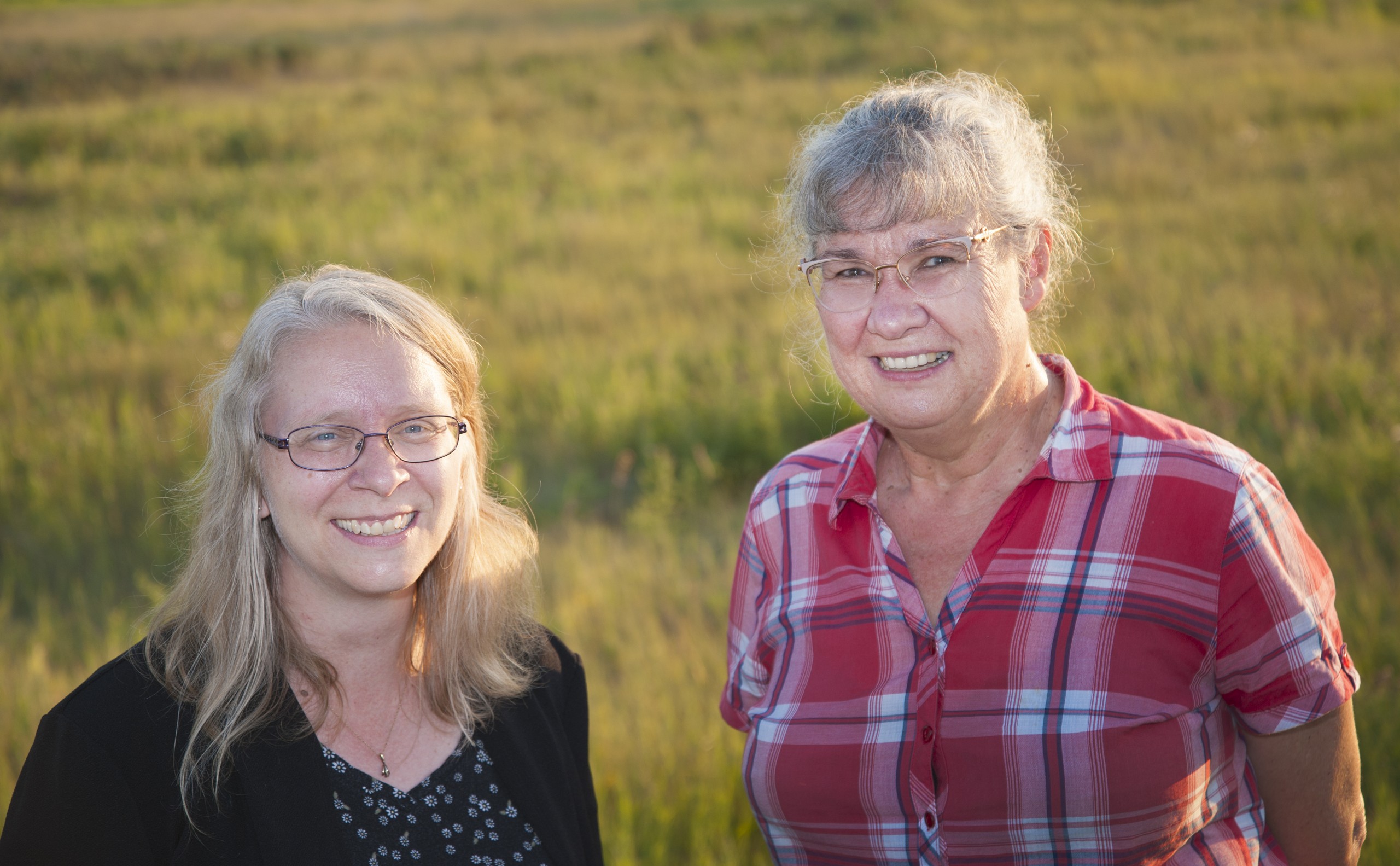 Photo by Steve Melrose
Photo by Steve Melrose
Sheryl Normandeau is a lifelong gardener, and holds a Prairie Horticulture Certificate and a Sustainable Urban Agriculture Certificate. She is a freelance writer specializing in gardening writing with hundreds of articles published. She is a regular contributor to Herb Quarterly, The Gardener for Canadian Climates, The Prairie Garden Annual, and many more. In addition to the gardening series, she is the author of The Little Prairie Book of Berries. She lives in Calgary.
@flowery_prose
Janet Melrose is a garden educator and consultant, and an advocate for Calgary’s Sustainable Local Food System. She is a lifelong gardener and holds a Prairie Horticulture Certificate. She has a passion for Horticultural Therapy and facilitates numerous programs designed to integrate people marginalized by various disabilities into the larger community. She is a regular contributor to The Gardener for Canadian Climates magazine. She lives in Calgary where she runs her education and consulting company, Calgary’s Cottage Gardener.
@calgaryscottagegardener

